KUXL
KUXL – 1570 KC
Unlike most metropolitan areas, the Twin Cities did not have a black radio station in the 1940s or ’50s. Minneapolis’ black population had been consistently at or below 1 percent from 1870 to 1940. In 1950 it was 1.3 percent, and in 1960 it grew to 2.5 percent. It wasn’t until 1964 that the community could support a station that played music that was primarily by and for the black community, and by that time young white listeners were embracing black music as well.
MOST NEGRO OWNED RADIO STATIONS INSULT TO RACE IS CLAIM
What would a black station been like if we had had one in the 1950s? Interestingly enough, in my KUXL file I found an article from the Minneapolis Spokesman, the black community’s weekly newspaper, dated December 26, 1958. It discussed an article in the December 3, 1958 issue of Variety, in which Richard J. Miller, president of St. Louis radio station KXLW claimed that:
Most Negro emphasis radio is a cheap insult to Negroes, a source of self-generated bigotry, religious quackery, charlatanism, and a wallow of ugly, primitive and harmful sounds. Any white man who lingers momentarily over a Negro emphasis station hears poor programming and crummy talk, he hears low down music, and is left with the strong impression that they are really different.
Miller estimated that there were an estimated 70 radio stations in the U.S. that programmed entirely for blacks, but felt that there weren’t more than a half-dozen of them that were sincere and tried to “program up” rather than “shoot down.” Announcers on white stations used their own names, while black DJ’s were given “the name of a clown, a name in keeping with the false and grotesque stereotype of the idiotic smiling Negro. He becomes Uncle Snuffy, Radio Daddy-O, The Cat Man.” He said that his stations was making a profit from its “enlightened” programming and others that followed are probably doing the same.
Food for thought.
THE LANPHIER ERA
Although Charles J. Lanphier of Milwaukee took out a construction permit for a new broadcast station on October 7, 1957, for some reason it took four years to be realized. The transmitter location was .3 miles north from the intersection of Sixth Ave. North and Highway 100 in Golden Valley, and the transmitter would be remotely controlled from the studio. The action was finally granted on July 19, 1961.
The new station would be broadcast at 1570 kilocycles, way at the top of the AM dial, at only 500 watts, daytime only. The address of the first transmitter and main studio was 7711 Sixth Ave. No. in Golden Valley, across from the Point Supper Club. This address doesn’t exist as Highway 55 was expanded.
On November 7, 1961, Will Jones reported in his entertainment column in the Minneapolis Tribune that the station was still awaiting its approval from the FCC to go on the air. It had hope to start broadcasting a week ago but was held up by equipment delays. Bad luck was cited, as it was the Twin Cities’ 13th radio station, and Lanphier pointed out that if you added up 1570 it came to 13. Jones explained that Lanphier was a former Milwaukee radio and TV man, and would act as the station manager as well as owner.
On the same day, Forrest Powers, TV and Radio reporter for the Minneapolis Star, indicated that the station would start broadcasting that weekend.
The station’s schedule wasn’t printed in the Tribune until December 10, 1961.
STAFF
The station’s initial staff included:
- Hugh Cardenas, formerly with KRSI, served as program director.
- Mort Garren
- John Sewall
- Jack Hyatt was brought in from Los Angeles
The promotional piece below pictures the station’s initial staff.
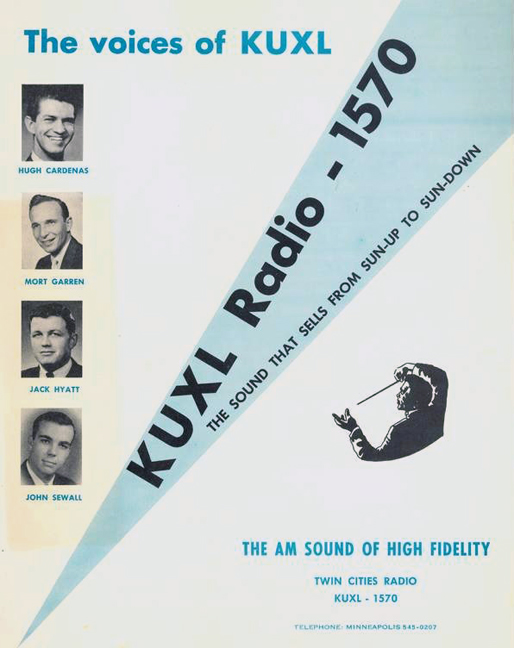
Below are the same four staff members that were pictured in the piece above, in a print ad.
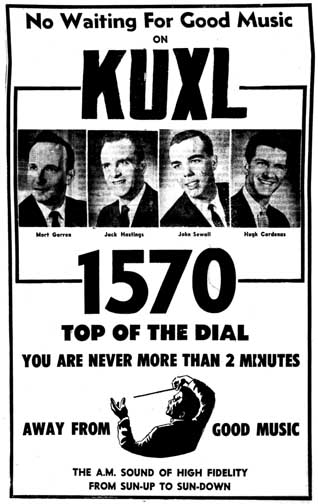
In April 1963, the listings showed Jerry Boyum on from 6 to 10 am, Mort Garren from 10 to 2 pm, and John Sewall from 2 to 7 pm. Long hours!
FORMAT
The music first played on KUXL was of the Percy Faith/David Rose/Henry Mancini/Peggy Lee/Bing Crosby/Lawrence Welk fare. Good music.
The format of the station is actually kind of ambiguous in this ad from the Minneapolis Daily Herald from September 13, 1962:
Radio is Sound!
KUXL Radio is a BETTER Sound
Hear it Yourself – Tune up to 1570 on your radio dial where you are never more than 2 minutes away from the Hi-Fi sound of good music, Associated Press news on the hour and half hour, latest in sports on the quarter hour.
You will enjoy tuning up to the quality sound of sound radio programming on KUXL. Top O’ The Radio Dial
Sun Up To Sun Down
The ad below was placed during the Cuban Missile Crisis:
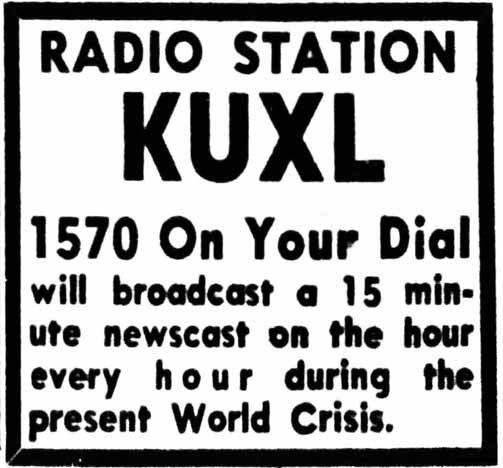
AWARDS
The ad below is from the Minneapolis Herald, the replacement paper started when the Star and Tribune were on strike in 1962.
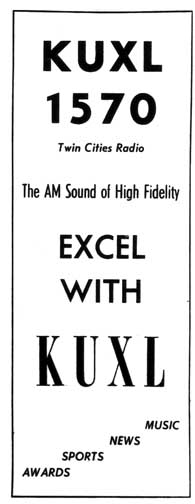
Note that one of the attributes of the station mentioned in the ad above is Awards.
The ad below boasts of their KUXL award for excellence in musical instruction.
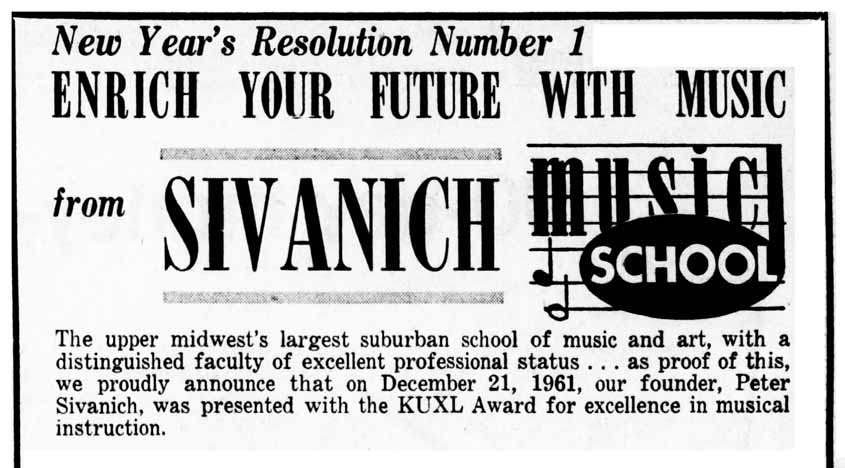
Alan Freed found another award made by the station to the American Legion North Side Post on May 1, 1962, for Excellence in Community Service.
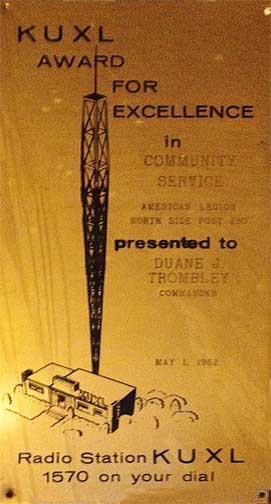
1963
ED SKOTCH AND GREATER HAPPINESS
On August 19, 1963, the station’s license was voluntarily assigned to Edward D. Skotch.
On August 28, Will Jones published an extended interview with Skotch. Jones described him as a “mild-mannered, blond, pipe-smoking sort,” who grew up in Chicago and worked in radio as a writer, director, and producer on radio shows and in TV when that city was its center of the early days. Skotch was the highest-paid director-producer in Chicago, with as many as six shows he created, network and local, being aired in town every week.
“Big Time TV” left Chicago and so did Skotch, going out to the West Coast and working as a director until he decided to get out of the rat race and become his own boss. With a couple of partners he bought a radio station in Cincinnati and turned it around, selling it at a profit. This time he was planning to do the same with KUXL, only without partners, using his life savings. “If it doesn’t do, I’ll be back in the rat race.”
Skotch’s idea was to create something new. Now that TV had grabbed everyone’s attention, and radio was just background music, he wanted to reverse the process and create “The Nation’s Most Attention-Programmed Station.” The key was to provide entertainment, but not with comedy or drama, but with ideas and thoughts. There were going to be 27 separate short entertainment features every day, ranging from the supernatural to what makes raindrops round.
Part of the plan was to tape all of the features for syndication and he figured there were 200 stations that could make good use of the material. He was in the middle of hiring, and was looking for a deep, authoritative, network kind of voice; a sirupy, romantic voice; and a thrid, more youthful and jolly voice. He’d also done some research in music therapy, and planned to play records for what they did for the listener.
He didn’t plan to start his new programming until he got a power increase from 500kw to 1,000kw. And as soon as he got that he would file for full-time operation and still more power.
He expected to shock some people that first day! He was keeping the call letters – their full potential had never been fully utilized. “K – You Excel. And we’ll supply material so that listeners can excel in certain areas of conversation.”
Meanwhile, the old KUXL crew was plodding on. September 7, 1963’s listings showed:
- “Oh What a Beautiful Morning” with Jim Eckert, 6 to 11 am
- “Melody Hall” with Mort Garren, 11 to 3 pm
- “Album Parade” with Jack Hyatt, 3 to 8 pm
But things were moving along. A construction permit was granted to install a new transmitter and a permit was granted to increase power to 1kw on October 1, 1963.
STATION TO BEFRIEND LONELY HOUSEWIVES
On October 3, 1963, Forrest Powers reported in the Star that
We’ll soon be the happiest group of radio listeners in the country. Last week Ed Skotch of KUXL announced plans to introduce features designed to cheer up the lonely housewives, and now Bill Stewart of WPBC says he has started a new format of “happy music” and other features of “make people feel better.”
For those who prefer to look on the gloomy side of things, there are always the daytime soap operas on television.
KUXL’s broadcast license was voluntarily assigned from Edward D. Skotch to Greater Happiness, Inc. (presumably his company) on October 7, 1963.
Forrest Powers published his own interview with Ed Skotch on October 7, 1963, in the Star. It held some interesting insights not revealed in the one Will Jones did (on August 18, above). the second line is pretty shocking: Skotch’s research concluded that the suburban housewife was a lonely person was too busy to hear her troubles and who tied herself in knots over small problems. His programming was designed to help said housewife by becoming an intimate, informative close friend that will cloud out the things that bug her. Skotch felt that once radio became a juke box and all talk was eliminated, the heart of radio was lost as well.
As a promotional gimmick, Skotch planned to distribute 100,000 “happiness charts,” which supposedly predicts the days when a person will feel cheerful or grumpy. He planned to conduct on-the-air “happiness” experiments twice a day.
Other short subjects would include “Can You Explain It?” a feature dealing with supernatural occurrences, and “Curiosity Corner,” a show touching on nature and science. The music would continue to be in the pop album category, but each selection would contribute to the pattern of feature material.
THE NEW, HAPPY KUXL
The ad below from the October 12, 1963, TV Forecast promises 72 daily features. The names of the programs may give an indication of what the station was like, apparently dispensing a lot of wisdom and advice. Those shows included:
- Questions Women Ask
- A Beautiful Thought
- Curiosity Corner
- I’d Like to Know
- My Favorite Funny
- Whiz Kid
- Unbelievable – Yet it Happened
- Inspirations for Daily Living
- Your Key to Happiness
- A Positive Outlook
- According to the Record
- Looking at Life
- I was Just Thinking
- This is Interesting
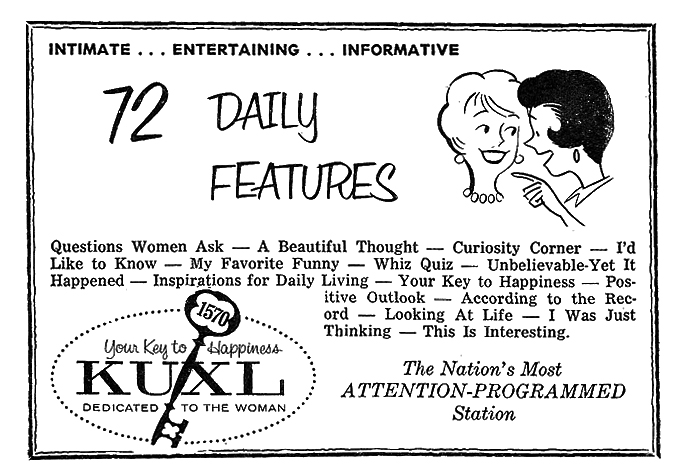
While newspaper listings are not 100 percent reliable, the Tribune’s listings of Monday, November 11, 1963, reflect the old format, with Jim Eckert from 6 to 11 am, Mort Garren from 11 to 3, and Jack Hyatt at 3.
Then, on Tuesday, November 12, 1963, we see a completely new kind of schedule – a Happiness Schedule!
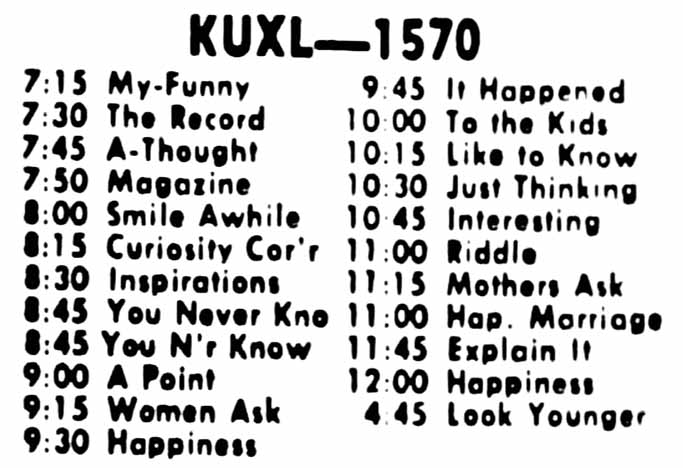
GOLDEN VALLEY INN
The very next day, November 13, 1963, the station’s permit was approved to change its studio location and remote control point to the Golden Valley Inn, a motel at 4820 Olson Memorial Highway. That address does not compute, but below is a photo of the Holiday Motor Hotel, described as being taken in 1955. This may or may not be the building in another iteration.
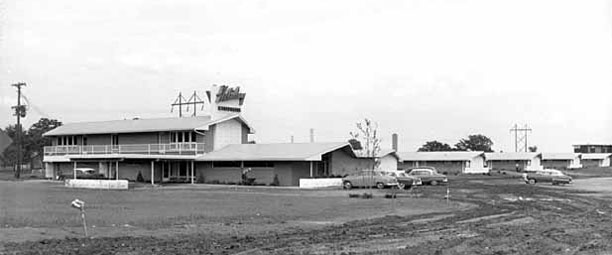
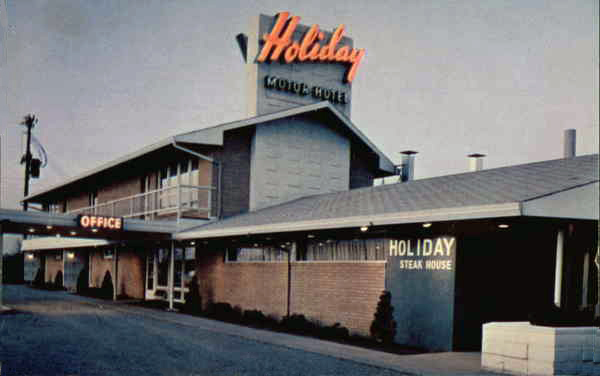
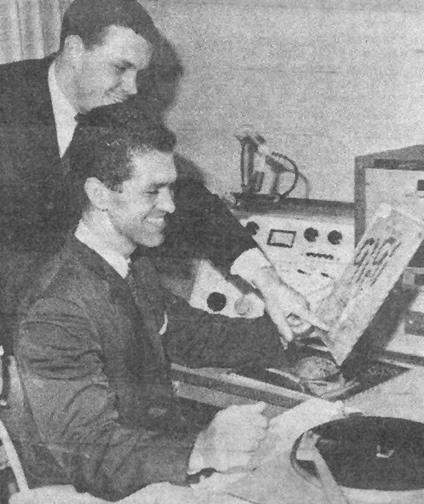
POWER UP
Although the records say that KUXL was granted the license to increase its power to 1000 watts on October 1, 1963, Will Jones of the Tribune did not announce the approval until February 17, 1964.
On February 26, 1964, Randall Hobart of the Star reported that Ed Skotch credited his women-oriented programming for a 480 percent increase in business since he took over the station. Three “informative features” were broadcast every hour each day to draw attention to commercial messages. Tom G. Morris was promoted to station manager and Robert E. Bowdan was named sales supervisor. Hobart also announced the increase in power.
1964
This ad appeared in March 1964. Wonder what E.I.I. was?
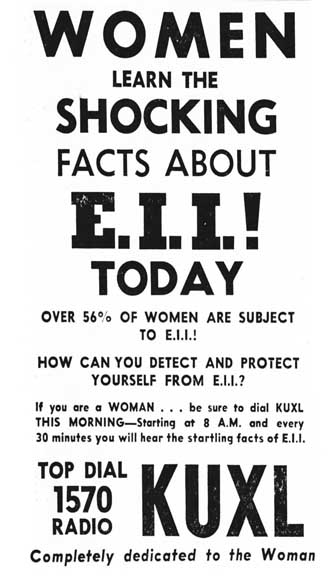
Will Jones reported in his column on March 12, 1964:
Of all the new for-women-only features on KUXL, the station reports the ladies are most interested in a feature called “The Unbelievable, Yet it Happened.” It’s about the supernatural. (The station, planning to syndicate its features nationally, has been looking for a mature, friendly, relaxed male voice in these parts. So far, they say, they haven’t found one. Call them, not me…
Forrest Powers of the Star filed his report on March 17, 1964, explaining how Ed Skotch was doing market research with a group of 40 housewives.
Pleased by the response to a recent project on emotionally induced illness, Skotch said the station will devote another day to the subject in the near future. He also plans to start an on-the-air school dedicated to “enriching the personality of the housewife who finds herself bogged down by dishes and diapers.”
FINALLY, SOME JAZZ
The first we hear of programming that was not Percy Faith and not (by this 21st Century woman’s standards) patronizing, comes in mid 1964. The ever-blessed Will Jones announced on June 5, 1964:
KUXL is airing jazz. Engineer Herb Schoenbohm, a jazz buff, started by emceeing a nightly 7 – 7:30 pm spot. [made possible by the late summer daytime hours] Now he also does a Saturday afternoon session from 1 to 5. And the response has been so good that the weekday evening jazz time may be extended.
Don Morrison of the Star revealed even better news in his “2 Cents’ Worth” entertainment column on June 20, 1964. Leigh (pronounced Lay) Kamman had presented jazz shows for years, lately on KSTP radio until that station summarily fired him along with a number of longtime staff for some unknown reason. Kamman went to New York, but fortunately returned to present this gift to the Twin Cities. The music played was from Kamman’s own encyclopedic library of records, domestic and foreign. He promised:
One day it may be modern, the next day flavor of blues. It will be historical and contemporary, sweet, hot, lowdown, enlightened Chicago style or very cool.
Kamman’s show, called “KUXL Jazz Club,” began on Monday, June 22, and aired Monday through Friday 4 pm to sundown and at 5 pm on Saturdays following Herb Schoenbaum’s “Jazz Festival.”
A license to install a new transmitter was approved on June 29, 1964.
GOODBYE, LADIES
All we have are newspaper listings, but on Tuesday, July 7, 1964, there is a full day of Ed Skotch’s programming for women, from 6 am until 4 pm when jazz takes over. “Look Younger” is on twice.
Then on Wednesday, July 8, 1964, we’re back to the old KUXL! Paul Franklyn at 6 am, Jim Eckert at 9, Mort Garren at 11, Jim Eckert again at 1 pm, and Leigh Kamman at 4.
July 12, 1964, brought the advent of Arthur Hoehn, who would become Fat Daddy Washington as the station became more black oriented. On his first day found in the newspaper, he was on in front of the Polish Hour and the Methodist Church, both 90 minute shifts in the morning.
On October 16, 1964, Will Jones announced that:
Jazzman Rio Pardo has undertaken a new KUXL show, heard at 10:30 am each Saturday and Sunday, called “Flying Along With Rio.” He stresses soul-jazz and airs a bulletin-board feature for the Negro community.
The program was one half hour long and started on October 17, 1964.
It gets better: Will Jones reported on November 27, 1964, that Leigh Kamman and Herb Schoenbaum had turned KUXL into an all-jazz station and breathed new life into it.
Ed Skotch gave up the ghost on December 1, 1964, when he voluntarily assigned his license to Universal Broadcasting Co. of Minneapolis-St. Paul, Inc.
MARVIN KOSOFSKY
As usual, Will Jones spells it out for us in his column of December 10, 1964. The situation was very ironic when he talked about the “flash success” of KUXL in the jazz field.
One day the station was just there, offering gimmicky, women-slanted programs, not attracting much attention. [This was what Ed Skotch wanted to be “The Nation’s Most Attention-Programmed Station,” remember?] And then almost overnight, or so it seemed, the jazz folk around town were talking about their station.
Jones explained how Schoenbohm (whom he calls Dave for some reason) and Kamman had talked the management into limited hours for jazz, and then slowly increased. Meanwhile the station was being sold, and they moved over to KQRS (which was then KEVE) to continue playing jazz after dark fell and KUXL was off the air.
The new owner of KUXL, Universal Broadcasting, had its headquarters in Shreveport, Louisiana. Its president was Marvin Kosofsky, who said he was not going to change the jazz programming, which had been taken over by Art Hoehn and Paul Franklyn. But, neither was it going to be a full-time jazz station as some had hoped. Leigh Kamman left to join KEVE, which became KQRS. Mort Garren left but “stayed on at KMSP-TV,” so apparently he was working at both places.
Kosofsky owned several other stations that catered to listener minorities, and the company represented a string of 30 special-interest stations. He expressed his intent to present commercial religious shows in the morning [commercial meaning they pay for the time?]. He wanted ethnic shows in Polish, German, and Scandinavian.
In an interview given for the Rondo Oral History Project of the Minnesota Historical Society, Yusef Mgeni remembered that KUXL “was a strange hybrid type of station. They would play gospel, and they would play Rhythm and Blues. And they would play some jazz, depending on which of the announcers was on or what day of the week or what time of the day it was, you’d turn the radio on and hear something different.”
RHYTHM & BLUES
In Will Jones’s interview of December 10, 1964, station owner Kosofsky said that out of the first 65 or 75 top markets in the country, ours was the only one that didn’t have a rhythm & blues station. And he noted that it was difficult to even find R&B records in town.
We’re starting a couple of weekend rhythm-and-blues shows as soon as we can get the records. And they’re going to be handled by Rio Pardo, who’s been doing a jazz show for us, and who will be the only Negro disk jockey in town. We plan to have him on two hours Saturday and two hours Sunday.
On December 16, 1964, afternoons changed from jazz to Rhythm and Blues. Some took it hard. One letter to the editor mourned the “Death of Jazz,” praised Herb Schoenbaum and Leigh Kamman, who “gave much to the betterment of good music in the Twin Cities,” and directed particular admiration to Paul Franklyn, who “flew the jazz banner through the wildest change of station ownership and programming this city has ever seen.” (Minneapolis Star, December 28, 1964)
It does appear that Kamman was still on the air at 3pm during the month of January 1965.
Secret Stash, Volume 1, Issue 1 (September 25, 2012), says that Kosofsky was the Chairman of Universal Broadcasting, and that his brother-in-law, Howard Warshaw, was the President. Much later, in 1977, Kosofsky would transfer his shares to Miriam Warshaw.
WOLFMAN JACK AND THE NEW JOCKS
Secret Stash indicates that Bob Smith arrived in January 1965. Bob Smith had created his Wolfman Jack character in 1958 at the 250,000 watt “border blaster” station XERF in Mexico, just over the border from Del Rio, Texas. The antics of the Wolfman were documented in the 1974 film “American Graffiti,” and were punctuated with ads for baby chicks (100 for $4), glow-in-the-dark statues of Jesus, and oldies albums from Uncle George’s Record Shop, owned by George Garrett here in Minneapolis.
The station’s license was always in the name of Universal Broadcasting during these years, so it is difficult to know what role Smith played at KUXL. He may have been a part owner of the company for a time, or he may have just been the station manager. He was not an on-air personality, although Secret Stash tells us that he once did a commercial in his normal voice and it was taped by a friend of Preacher Paul’s who was learning how to run the board. And it is impossible to do a newspaper search on “Bob Smith.” He did continue to make Wolfman tapes in the Golden Valley studio and ship them to Mexico.
Wednesday, February 10, 1965, was the first day the newspaper schedule showed Paul Anthony‘s name. “Preacher Paul” (nee Ralph Hull) had come from KDWB and it appears that he was working at both stations until June 1965.
May 17, 1965, saw the introduction of Billy G to the announcing staff, when the sun stayed up long enough for another shift. I know nothing about Billy G! But stay tuned.
DANCES
KUXL sponsored dances at various venues, and brought in national acts. In addition to the ones listed below, Preacher Paul expressed an interest in booking act such as Chuck Jackson, Jimmy Reed, Junior Walker, Marv Johnson (he lost $20 on that show, he told Secret Stash), Al Green, Wilson Pickett (emceed by Lord Jeffrey), Fats Domino, the Supremes, Joe Hinton, and his “pride and joy” – the Righteous Brothers. We’ll hear more from Preacher Paul down below. Meanwhile, here are some of the dances the station sponsored.
Bobby “Blue” Bland might have been the first KUXL show, appearing on July 22, 1964.
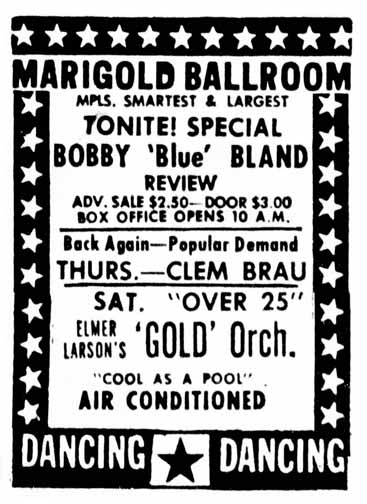
Bo Diddley got the Marigold going on August 19, 1964. It was the same night Count Basie was at the Prom, and a conflict was feared, but Will Jones reported that Mr. Diddley drew 1,500 “sweating youngsters, ” and the Count drew 1,350 “oldsters.” (Minneapolis Tribune, August 21, 1964)
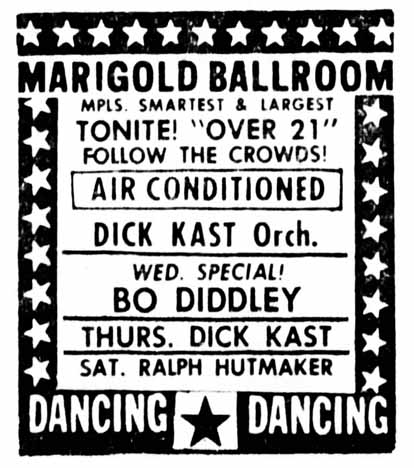
The Tams made an appearance on Sunday, August 23, 1964.
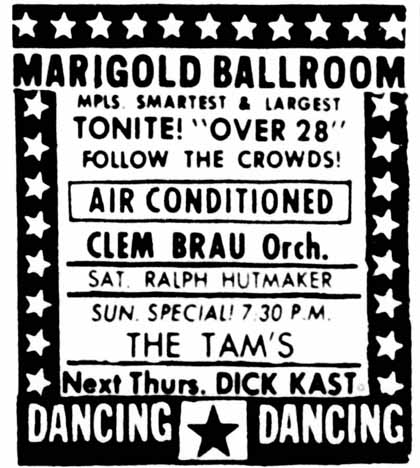
Bobby Freeman, who did “Let’s Do the Swim,” came to the Marigold on Sunday, September 27, 1964.

The epic blizzard of March 1965 prevented Bobby “Blue” Bland from making a KUXL-sponsored dance at the Marigold, but a local musician was found to substitute, admission price was lowered, and the event still drew 2,600 people.
The Impressions made an appearance at the Marigold on Sunday, April 11, 1965.
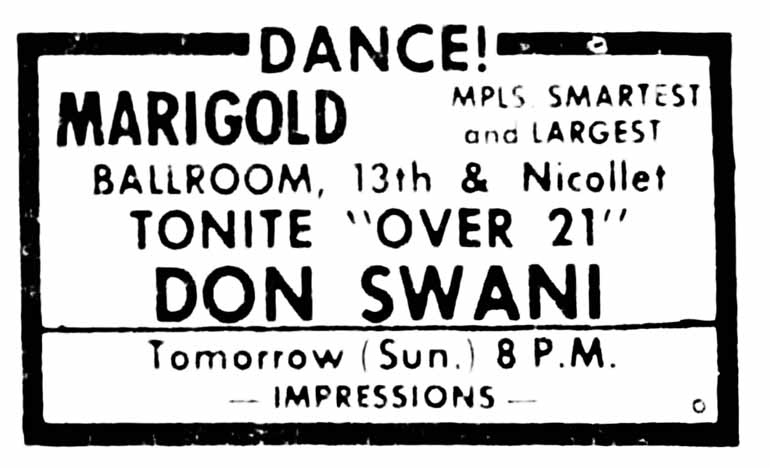
Solomon Burke performed on May 28, 1965. Two days before, Will Jones reported:
Solomon Burke, who has taken to wearing kingly robes and calling himself King Solomon, is booked for a Friday night bash at the Pick-Nicollet Hotel, promoted by a young married folks’ group called The Weekenders. Burke will proclaim KUXL’s Preacher Paul regional king of rhythm and blues at the event.
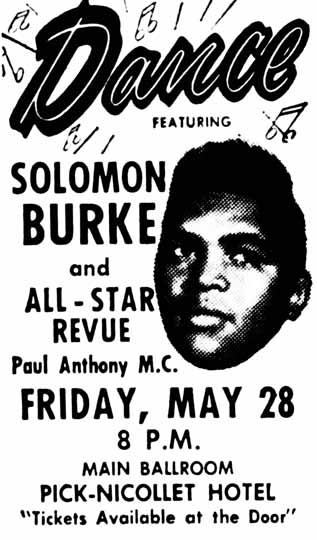
The Temptations were scheduled to perform at the St. Paul Auditorium on July 12, 1965, sponsored by Preacher Paul and KUXL. Will Jones reported that they would alternate with the local R&B group, the Amazers. I found no other advertising in the Minneapolis papers, but the St. Paul papers are not online.
Ike and Tina Turner appeared at the Minneapolis Auditorium under the auspices of Preacher Paul and KUXL on August 1, 1965. The show was not widely advertised. I love Will Jones, but this one is listed under “Weekend girlwatching tip.” MCP. July 30, 1965:
Talkative Tina Turner, who interrupts her love songs to give long, impassioned discourses on life and love in the middle of rhythm-and-blues records played mostly on KUXL, will be at Minneapolis Auditorium Sunday night. It’s billed as the Ike and Tina Turner Revue, complete with nine-piece band, singers Bobby John and Jimmy Thomas and a girl trio called the Ikettes. But it’s also a dance session. KUXL and Preacher Paul Anthony are the sponsors.
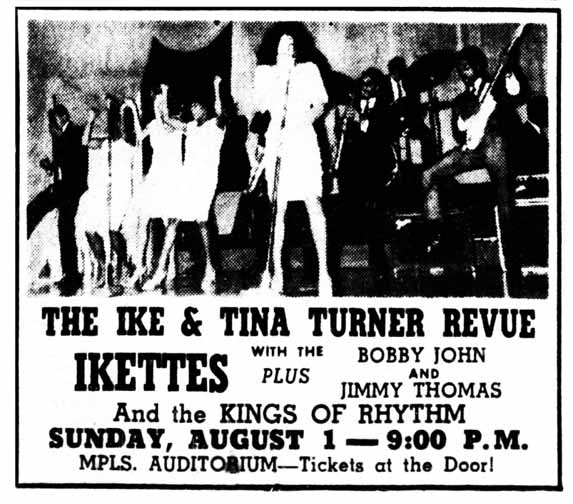
Preacher Paul reported that the show drew an audience of 5,000 people!
FOUR TOPS FRACAS?
Okay, here’s a puzzle. In the September 1965 issue of Twin City a-Go Go magazine, Preacher Paul had a column called “Here’s Hip Happenings.” At the end he talked about the concerts, and said that as he was writing the article, the most recent one was the Ike and Tina Turner concert on August 1. He also said that the Four Tops were two days away with an expected crowd of 2,000 or more at the Marigold Ballroom. And then he said that B.B. King was also coming to the same ballroom on September 12. Now. Not knowing when he was writing the article, one would suppose that the Four Tops was between Ike and Tina and B.B. King, right? Well, I found no evidence whatsoever of the Four Tops show, but I did find this:
On August 23, 1965, a fracas broke out involving 400-500 young people throwing eggs and rocks at cars, about a block from the Marigold Ballroom. Or so reported the Minneapolis Star the next day. Except that police reported that the incident only involved “several” youths. (And where would they get eggs?) One 20-year-old was arrested. Half an hour later, police were called to break up the crowd of 200 who had gathered outside the Ballroom when an “unidentified youth discharged a fountain pen tear gas gun. Police said they did not use tear gas to break up the crowd.” Or so reported the Minneapolis Tribune, the day after that. Efforts to find out who was playing that night were fruitless.
BB King performed at the Marigold on September 12, 1965.
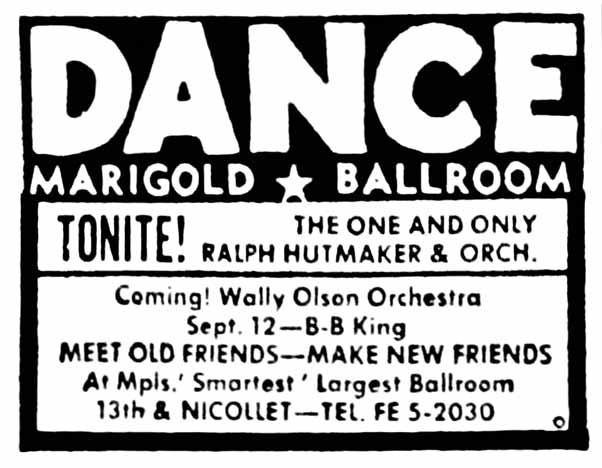
Jackie Wilson was scheduled to perform at the Marigold on January 14, 1966, but didn’t arrive until midnight, causing a “near-riot” at the ballroom when the 1,600 people in the audience “became annoyed.” Police were called and the City Council discussed the matter. (Minneapolis Tribune, January 27, 1966)
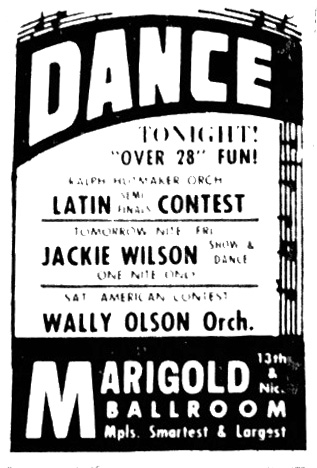
Rufus Thomas appeared with local group the Amazers on June 24, 1966.
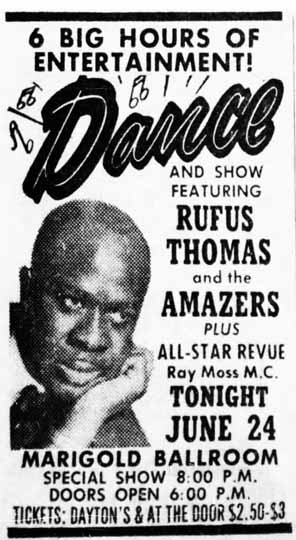
The Temptations came to the Marigold on October 16, 1966, and police had to be called when 800 to 1,000 people on the sidewalk got impatient waiting to buy tickets at the one ticket booth. Police shut down Nicollet Ave. and were heckled by the crowd. The glass in the ticket booth was broken in two places, but Ballroom manager Elmer Larson insisted that there was no danger of the crowd getting out of hand and that the booth broke because it was “poorly constructed.” One person was sought for breach of the peace. (Minneapolis Star, October 18, 1966) Interestingly, the name of the act was never mentioned in the news reports.
KUXL hosted the Impressions at the Marigold Ballroom on January 22, 1967. Also appearing were the Amazers.
James Brown and His Revue appeared at the Minneapolis Auditorium on April 25, 1967. It was emceed by Jack with KUXL, and is believed to be the first appearance of Brown in the Twin Cities.
Checker recording star Little Milton, with local band Maurice McKinnis and His Fabulous Blazers, appeared at a dance at the Minneapolis Armory on Friday, April 12, 1968. The show was emceed by KUXL’s Jack Harris and Billy G. Little Milton’s hits were listed in an ad in the Insider as “We’re Going to Make It,” “Blind Man,” and “More and More.”
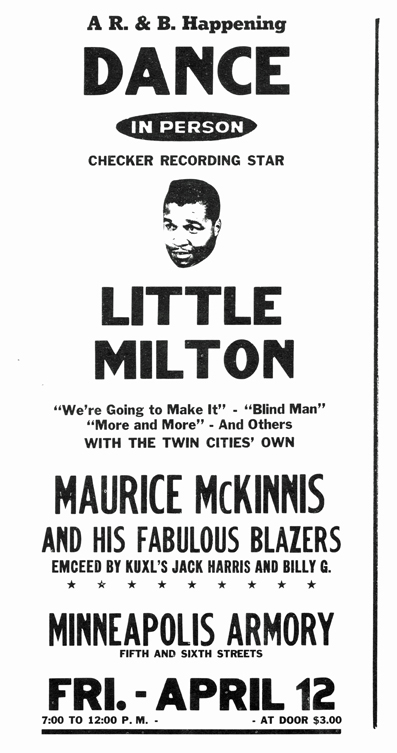
TRAGEDY AT STEM HALL
On August 30, 1968, a concert and dance was held at Stem Hall at the St. Paul Auditorium, emceed by Jack Harris, a/k/a KUXL disc jockey Daddy Soul. Performers included:
- Syl Johnson
- Maurice & Mac
- Willie Walker and the Exciters
- Maurice McKinnis and the Blazers
These groups were well known in clubs like King Solomon’s Mines where Soul music was a staple.
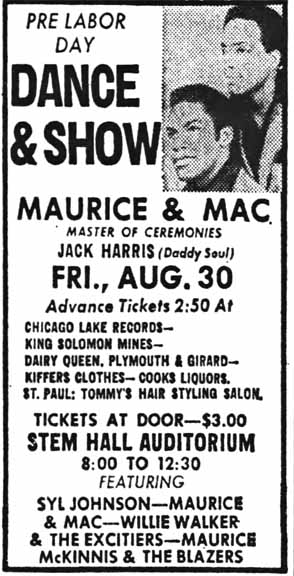
What should have been a fun night turned into two nights of fear, anger, and violence – not only because of a situation handled poorly but because of underlying conditions that faced black communities all across the country.
The facts, as reported in the newspapers and in investigative reports approximate these. About 350 young people, mostly black (I’ll use that word instead of the word Negro used at that time) were in attendance. One young man was in a rest room with some others who were drinking, and he flashed a gun. It was never clear whether he used it or even who he was. Two off-duty policemen who were hired for the event came on the scene and took the gun away from him and tried to arrest him. They were attacked by about 20 men who tried to retrieve the gun. The policemen called for backup and the melee started. A gunshot was heard and a policeman was hit in the arm or hand. The shooter was never identified.
At that point, having lost the opportunity to peacefully arrest the young man, the police decided to use nightsticks to bar the door to the hall, keeping the people in. They broke through one of the doors, and then the police decided to keep them back by lobbing teargas into the crowd. Thus incited, the crowd began yelling invectives at the police and throwing furniture at them. Once outside the missiles became rocks. Mob violence ensued and the car of KSTP-TV newsman Dave Margeson was smashed by rocks and a piece of wood; he was treated and released from the hospital. The crowd moved west down 4th Street, smashing store windows, until they got to the Selby-Dale neighborhood, where many of the City’s 10,000 black people lived in what could only be described as a ghetto. The disturbance was considered contained by 2:30 am.
Seven people were arrested the first night. Two of them, a married couple, were from Minneapolis, and they had a loaded submachine gun in the trunk of their car and a .45 pistol under the seat. Whether this was related to the disturbance was not quite clear.
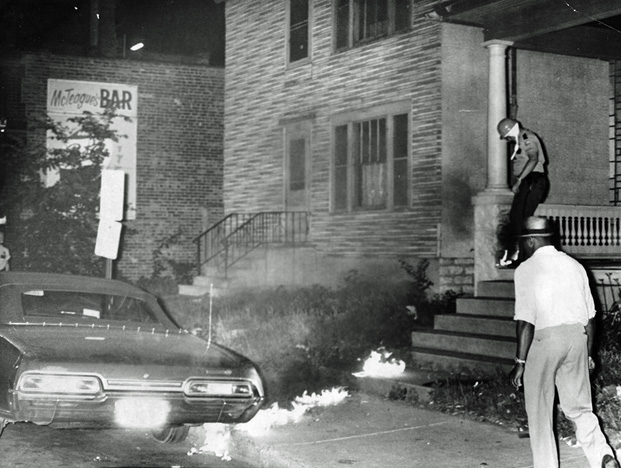
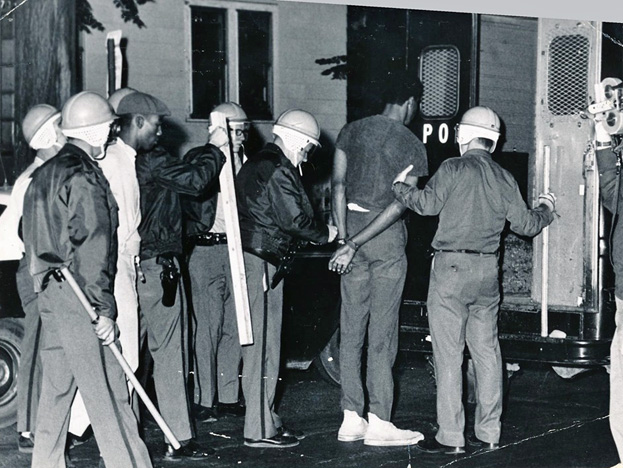
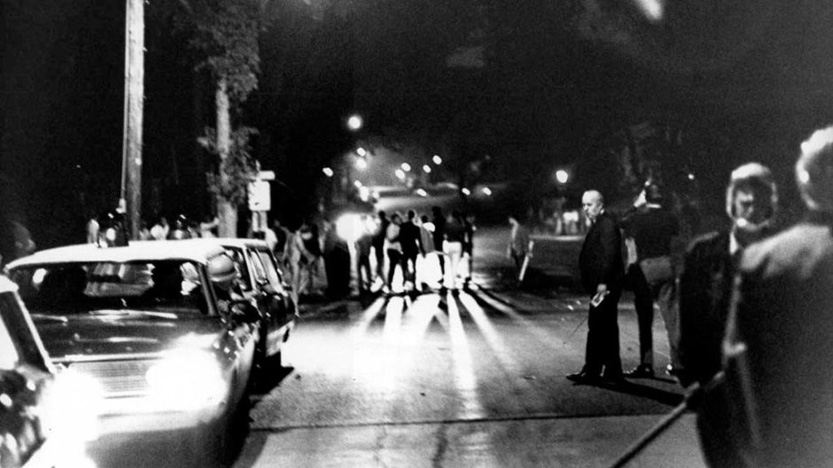
The next night, violence continued on its own momentum. At about 9:30 pm, someone with a shotgun wounded three police officers who, with about 20 others, were trying to break up a crowd of about 200 who had gathered at the site of a firebombing. A police command post was set up at the St. Paul Cathedral, and two-man tear gas units were sent around, with police at every intersection. Cars were prevented from coming into the area from Interstate 94 at the Dale Street exit. Four businesses were fire-bombed and fire trucks were met with sniper fire but no one was injured. Ten people were arrested, most for carrying firearms. Two white youths from upstate Minnesota were arrested in a house when spotted brandishing a shotgun on a balcony.
In the wake of the incidents, a committee was formed by the St. Paul Urban Coalition to investigate them. Sixteen pastors gathered to support this action and expressed their concern that the investigation be impartial and representative. The St. Paul Urban League and the St. Paul Human Rights Department also launched their own investigations. Meanwhile, the Mayor and others defended the actions of the police and laid the blame squarely on the “mob.”
The report by the St. Paul Human Rights Department, released in February 1969, placed the blame for the disturbances mainly on how the police handled it. While their job was to arrest one man with a gun, they instead barricaded the door of the hall with their night sticks and used tear gas to subdue the crowd. An underlying cause was said to be the overall condition of the Selby-Dale area.
The report of the St. Paul Urban Coalition, headed by Arthur S. Fleming, President of Macalester College, was released in March 1969 and echoed the first but was much more detailed and damning. The decision of the police to bar the door and throw teargas into the hall was roundly criticized. A policeman knocked down pregnant woman, pulled her hair, and threw her into a wall. A 15-year-old polio victim was smashed, face-first, into the pavement and sent home bleeding. The biggest troublemakers appeared to be a group of about 30 from Minneapolis, dressed in boots, Levi jackets, blue jeans, and cowboy or Australian “digger” hats.
And although much of the 96-page report centered on the disturbances themselves, the committee had plenty to say about “discrimination patterns in housing, education, recreation, employment, welfare, and police-community relations, and includes recommendations for improvement in those areas.”
Sources:
- Minneapolis Tribune, August 31 to September 2, 1968
- Minneapolis Star, August 31, 1968
- Minneapolis Tribune, February 2, 1969
- Minneapolis Star, February 6, 1969
- Minneapolis Tribune, February 9, 1969
- Minneapolis Tribune, February 12, 1969
- Minneapolis Tribune, March 19, 1969
- Minneapolis Star, May 7, 1969
I’m going to jump back a little into the chronology of events at the station after listing all of the concerts I could find. We were kind of in the middle of 1965. Remember that this website only goes up to 1974, and I did do a thorough search on Newspapers.com for KUXL and other offshoots.
1965
DIAL AWAY YOUR WORRIES
Will Jones dedicated most of his April 22, 1965, column to the station, saying, “Life is simpler on KUXL.” He declared that hip teenagers were abandoning the standard rock ‘n’ roll stations late in the afternoon to tune in to Preacher Paul Anthony.
Preacher Paul is no preacher. (KUXL is loaded with preachers earlier in the day, but most of them are called Brother or Doctor.) Preacher Paul is a disc jockey. He plays what the station management calls race music, and what is perpetrators call soul music.
One of the big sponsors was the Celebrity Lounge, where you could hang out with the owners, Minnesota Twin Earl Battey and former Gopher quarterback Sandy Stephens. “And when you’re there, you’re a celebrity.” The Twins management “got riled at the implications that its star catcher and other players were hanging around a saloon, and protested,” so the Preacher toned it down.
REMOTES
Billy G, the Prime Minister, started doing daily remotes from the Cassius Bar and Cafe on May 4, 1965, from 6 to 7 pm. The show was called Rhythm ‘n’ Blues Time. On May 27, 1965, Will Jones noted that with Daylight Savings Time and sundown getting later Billy G would be able to “wail with the records” from Cassius’ Bar until 9 pm.
On June 6, 1965, Jones dedicated a long, three-column article to the concept of “Soul Food,” saying that while Billy G made it sound good, it was hard to come by. The problem was that by the time he got to a place that had soul food, it was all gone. They made a big pot of it at noon, and when it was gone, it was gone, seldom lasting past 5pm. He finally had some blackeyed peas on New Year’s Eve, and other successes after that.
Meanwhile, Preacher Paul was bugged at being in a hot studio from 2 to 6, so starting in mid-June he was going out in a mobile trailer to broadcast from various outdoor locations around the Twin Cities.
The mother of all remotes was when several people from the station took over the Ebony Lounge, which was located in St. Paul over Roadbuddy’s Barbeque. Preacher Paul was there three nights a week as a host, and on Saturday afternoons he broadcast from the place. Both Will Jones (Tribune, November 2, 1965) and Preacher Paul (Twin City a Go Go, Holiday 1965) wrote about the place, and how they installed 14 of the finest foxes you’d ever want to see, a sound system that’ll knock the buckle right off your belt, some of those sweet, gone, pine-toppin’ KUXL sounds, and crowds of out-a-sight swingers. (Guess who said that?) Five or six foxes shake and gyrate on the stage each night to KUXL records, and Jones assures us they are the liveliest of them all.
CHANGES
Schedules and staff were changing that winter of 1965, with Preacher Paul slipping into semi-retirement, working only Saturdays from 1 to 5:30, remotely from the Ebony Lounge. He said Ronn the Rajah would broadcast from 1 to 2pm Monday through Friday, and then Ronn and Billy G the Prime Minister would alternate every half hour. I wonder how long this crazy schedule lasted! My DJ page tells me that Ronn the Rajah of Rhythm & Blues’s real name was Ron Samuels – the one who married Wonder Woman? On November 16, 1965, the 2:00 listing in the newspaper for KUXL simply read “R&B Express.”
Apparently the scene with the Fourteen Foxes didn’t last too long. A note in the Minneapolis Tribune dated December 10, 1965, said that “The discotheque scene at St. Paul’s Ebony Lounge which disappeared a couple of weeks ago, is back in action, with much the same cast, at Big Al’s in Minneapolis. KUXL’s Preacher Paul is promoting it once more.”
1966
POLICE END SWING THING
Oh Oh. Dateline Minneapolis, March 13, 1966. Labor Temple, third floor. “Charlie Smith and Preacher Paul Sunday swing thing. Take the elevator,” said the sign. So two cops from the morals squad took the elevator and found 150 men and women, a four-piece band, 36 tables and a 15-foot liquor bar with 54 quarts of liquor, 21 bottles of beer. They also reported that people were buying tickets for 50 cents entitling them to buy drinks. Oh so many levels. The cops busted four men and three women for selling liquor without a license (and on a Sunday!). Those seven people included Mr. and Mrs. Preacher Paul. Interestingly, he was listed as age 29, she 24. In fact, all were in their 20s. And, those cops took $350 in cash. (Minneapolis Star, March 14, 1966)
STATS FROM BILLBOARD
Here in my file is a page out of the July 9, 1966, issue of Billboard magazine, where the information about KUXL lives. Let’s do bullets:
Music Format:
- Rhythm & Blues: 60 percent
- Jazz: 25 percent
- German, Polish, Country, Old-Time: 15 percent
Special Programming:
- R&B Dedication Line
- B’nai Shalom Program
- German Hour
- Polish Hour
- Comedy LPs on Art-Art’s Dedication Line
- Maury Bernstein and Folk Music
Douglas Rice, Director of 3-man news department
General Manager: Robert W. Smith (Wolfman Jack)
Program Director: Arthur A Hoehn
MORE CHANGES
In July 1966 (Smith sold out to Kosofsky?) and went back to Mexico, this time to XERB, a 50,000 watt station in Tijuana. Art Hoehn and Ralph Hull left with Wolfman, either to Mexico or Southern California. In 1974 the Wolfman was into many projects, including a weekly syndicated show that was broadcast here on KDWB. The Wolfman died on July 1, 1995.
November 1966’s In-Beat magazine included an interview with the station’s new DJ and Program Manager, Ray Moss. He came with no radio training at all – in fact, he was a bartender – but the station executives were impressed with his verbal fluency and vast knowledge of music. He was hired to do the jazz show, but moved to take over the R&B show when that opened up. He did his own programming, and said he loved his job. “After all, it’s a thing to be able to sit down and listen to sides all day.”
There was also a Richard Nelson, who Connie Hechter at the Insider called Dick, but he actually was known as “Admiral Richard E,” and was on the air from 1966 to 1968, according to Curt Lundgren (who says he would cringe at the name “Dick.”)
Lord Jeffrey, (Jeff Diamond) came to work at KUXL in 1967, when he was about 15 years old. Dan Pothier (pronounced Poh-SHAY) worked at the station around this time as well.
1967
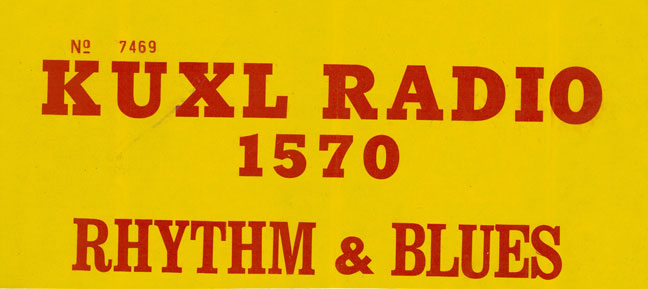
On June 12, 1967, the station’s application to change its studio location to 5728 Wayzata Blvd. in Golden Valley was approved. Curt Lundgren, who would go on the air as Evan Curfew, tells us that the studio was in the basement of the South Side Lumberyard Building, right behind McCarthy’s Restaurant on what is now 394. In the photo below, the KUXL trailer is in the parking area behind the building. “Luxurious digs, no?” says Curt.
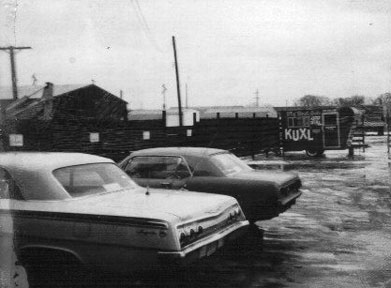
From the Insider, September 30, 1967:
Good New Show on KUXL: Saturday at 5:00 pm is the time to listen to all the old hits on “Bill Blast Hits of the Past.” The show, hosted by Al Collins of Music City, downtown Minneapolis, received good response from listeners. Al, by the way, happens to be a very knowledgeable fella, record wise. He truly loves the business.
1968
The Insider reported that Evan Curfew was playing a Solid Gold Oldies All Request show on Saturdays from 1 – 5 (am or pm?) in February 1968.
On April 13, 1968, Billboard reported that Ray Moss had gone to California for a job with XERB, but returned quickly and with a new name: “Daddy Soul.” The Insider reported that Moss became the new music director in April 1968, and was on-air from 3 to 7, Monday through Friday.
According to the April 13, 1968, issue of Billboard, “Chess Records artist Jack Harris is now doing a show on the R&B station…” Jack Harris, the proprietor of Black & Proud records, became “Daddy Soul.” The Insider said that he was on-air just an hour a day during the week and from 1 to 3:30 on Saturdays. He was program director from 1968-1971. See more about Harris under his listing on the Disc Jockey page.
1969
On January 15, 1969, Minnesota Human Rights Commissioner Frank C. Kent announced that Ray Moss, who had charged KUXL with discriminatory practice in employment when it discharged him, had been been restored to his position. (Minneapolis Tribune, January 16, 1969)
The station’s request to change the location of the studio to 5730 Duluth Street in Golden Valley was approved on October 14, 1969.
1971
In the September 1971 Insider, reviewer Will Shapira profiled W. Amos Johnson, who did a two-hour jazz show on KUXL each Sunday. Shapira wrote about how difficult it was to sustain a jazz show in Minneapolis, and how Johnson, first hired early in 1971 to do the news, wanted to give it a try. Johnson mostly played what was termed easy-listening jazz: Isaac Hayes, Shirley Bassey, George Benson, Herbie Mann, Herbie Hancock, etc. He didn’t want to scare people away, and he wanted to lure sponsors to the program. As it stood, it was then peppered with public service announcements rather than the preferred commercials.
The schedule on December 30, 1971, shows Rhythm & Blues programming from 1pm until dark and 6 am until 6:45 am.
1972
A Super Soul Thirty countdown dated July 1, 1972, pictures DJ Thomas Love and Music Director Jimmy Smith (
A newspaper schedule dated December 19, 1972, shows the same “preacher tapes,” as Ray Moss called them, from 6 am to 1 pm. Then there was alternating R&B and Rap at various intervals.
On December 29, 1972, KUXL announced that it was abandoning rhythm & blues in favor of a telephone talk show. Station manager Jim Peterson said the change, effective January 1, 1973, will involve afternoon programming only, with religious programs to stay on the station’s schedule until 1 pm daily. The station’s R&B programming had averaged about two hours daily during recent months when the station’s sign-off time – local sunset – had been late afternoon. Peterson cited economic factors as the reason for this change.
1973
In January 1973, KUXL officially went out of the R&B business – at least for a while – and began a talk show format. Jim Peterson, station manager for the last year, said no matter how much sense it made, nobody would buy commercials for a little 1,000 watt, AM daytimer station. Peterson gave the example of Hamm’s and Grain Belt beer – highly patronized by the black community, but refused to buy time on the station.
Yusef Mgeni, a radio-television program supervisor for U of M station KUOM and member of the Malcom X Pan Afrikan Institute, found the argument lacking, going so far as to accuse program director Mike Cunningham of having “racist and oppressive views.”
Disc Jockey Fat Daddy (a/k/a Jimmy Smith) cited statistics that out of 32,000 blacks in the potential audience, between 10,000 and 15,000 listened to the station. Unfortunately, the American Research Bureau came in at fewer than 1,000 listeners at 3 pm on a week day.
The new schedule kept the morning religious shows, which did have sponsors and paid the bills. Peterson said R&B “never even paid salaries.” From 1 to 3, Mike Cunningham would be on the air, and then from 3 to 5, Paul Helm, the man people loved to hate. It was Helm that people petitioned to have on the station more than anything, after trying him out on a trial basis starting in the middle of 1972. (Minneapolis Tribune, January 2, 1973)
1975
For the first time since 1973, black music was again on the radio, with a new disc jockey named Pharoah Black (nee Thornton Jones). The show, “Pharoah Black’s Soul ‘Til Sundown,” began on May 1, 1975, and ran from 7 pm until sundown. It provided music and information “for and about black people in this city and around the world.” Black, age 28, was a graduate of Brown Institute, and had been working at WCCO. He actually bought the time from KUXL himself and sold commercials to pay for it. (Minneapolis Star, April 30, 1975)
During the show, black broadcast community news, and an educational series called “Red, White and Blue in Black.” The program also kept in touch with other black media programs like the black TV show, “Harambee.” He started the black show because whatever black programming there was was scattered – a half hour on one station and 15 minutes on another. “I thought if we could get somewhat organized on a daily continuous basis that it would be a step in the right direction. “I’m going to try Minnesota to the bust before I try and move on someplace, because I feel that black programming is needed here more than anyplace else.” (Minneapolis Star, August 3, 1976)
1976
The Centennial Rhythm & Blues Show was the brainchild of Lamar Adams, who shared his collection of more than 4,000 recordings starting in May 1976. It was started through his Minneapolis Brokers Association, which bought the two-hour Sunday time slot from KUXL after Adams and his associates sold enough advertising.
The music spanned the black musical spectrum, from bebop to pop, delta blues to Motown, Dixieland to the Philadelphia disco sound, said Adams. Staff included Gary (The Deacon) Johnson, a blind disc jockey. Despite the station’s weak signal, the show received over 1,500 letters in four months.
Unfortunately, by September 1976, the program’s two advertising contracts had expired, and Adams was unable to find new sponsors. Once again, the small black population in Minneapolis was cited as a reason not to sponsor the program, although white people were clearly listening as well. (Minneapolis Tribune, September 7, 1976)
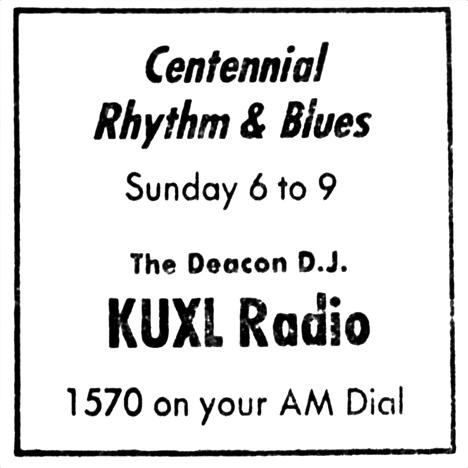
Pharoah Black introduced Earth Wind and Fire, with the Emotions and Wild Cherry at their October 7, 1976, concert at the Met Center. At the time he was operating two mobile discos called “Soul on the Roll Disco Rendezvous.”
1977
Apparently all this time, the station was still owned by Universal Broadcasting, which, when it was purchased, was controlled by Marvin Kosofsky. On April 28, 1977, there was a voluntary relinquishment of positive control of Universal from Kosofsky to Miriam Warshaw, if I’m reading this right.
On December 20, 1977, a permit was approved to change the tower location to 5650 St. Croix Ave. in Golden Valley. The old tower was removed and a new tower erected.
1978
In 1978, promoter Tom Tipton noted that KUXL played only 11 hours of soul music per week. (Minneapolis Star, March 17, 1978)
On August 22, 1978, a construction permit was approved to increase the station’s power to 2.5 kw.
1988
The call letters of KUXL changed to KYCR on May 19, 1988.
KYCR changed to KDIZ on December 24, 2015.


